“Grim Reapers”
Eagle History
The 493rd Fighter Squadron, nicknamed the ‘Grim Reapers,’ at RAF Lakenheath, England, was the last F-15C fighter squadron in the U.S. Air Forces in Europe. The mission of the 493rd FS was to rapidly mobilize, generate, and deploy combat ready F-15C aircraft and people to perform air superiority and air defense missions in support of U.S. and NATO war plans and commitments. The 493rd FS began to receive their Eagles on November 15, 1993, when F-15C 86-0164 and F-15D 86-0182 arrived from Bitburg Air Base, Germany. The delivery was in readiness for the reactivation of the squadron, which officially took place January 1, 1994

The Air Force reassigned several aircraft belonging to US Air Forces in Europe in fiscal 1999. The moves complied with a 1996 Combat Air Forces decision to return fighter squadrons to a standard size of 24 primary assigned aircraft, and allowed USAFE fighter units to better-support normal operations during partial squadron deployments. Command fighter units were previously made up of 18 assigned aircraft. The reorganization affected Spangdahlem Air Base, Germany, and Royal Air Force Lakenheath, England. Spangdahlem’s 23rd Fighter Squadron gained six F-16 aircraft from the Combat Air Force’s attrition reserve fleet. The air base’s 53rd Fighter Squadron, comprised of 18 F-15C aircraft, was deactivated. Six of the aircraft moved to Lakenheath’s 493rd Fighter Squadron, and the remaining aircraft were transferred to Air Combat Command.
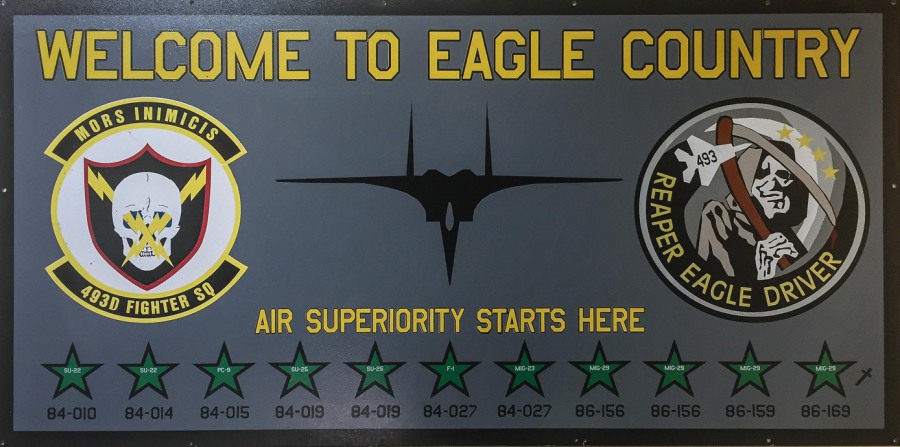
The squadron was recognized as the best air superiority fighter squadron in the entire U.S. Air Force after receiving the Air Force Association’s coveted Hughes Trophy award for 1997 and 1999. When you think of air-to-air dominance, you don’t have to look any further than the 493rd Fighter Squadron. With a rich history, the U.S. Air Forces in Europe’s first air-to-air team has shown time and time again they deliver like no other squadron in the Air Force. From the 1998 USAFE Squadron of the Year honors, to leading maintenance stats and air-to-air victories on the field of battle
While not a player in Deliberate Force, Lakenheath’s 493rd Fighter Squadron has played major roles in coalition contingencies such as Deny Flight and Provide Comfort, using F-15C fighters equipped with electronic systems and weaponry designed to find and attack enemy aircraft. And with a full complement of air-to-air weapons – AIM 7-Sparrow, AIM-9 Sidewinder and AIM-120 AMRAAM missiles – it provides a perfect partner for the Strike Eagle.
In the summer of 1996 some 500 people, 36 jets and tons of equipment moved to Incirlik as the 366th Wing from Mountain Home Air Force Base, Idaho, mounted the largest single unit swap out in the five-year history of Operation Provide Comfort. The 366th Wing deployment brought a force equal to nearly half of all Air Force people assigned to OPC. They replaced the 23rd Fighter Squadron from Spangdahlem Air Base, Germany, along with the 492nd and 493rd Fighter Squadrons from RAF Lakenheath, England.
The 493rd Fighter Squadron deployed in late 1997 from Royal Air Force Station Lakenheath, England to Incirlik Turkey. As part of the 48th Fighter Wing from Lakenheath the unit has regularly supported Operation Northern Watch. The 48th FW brings a composite force of F-15C’s and F-15E’s from Lakenheath to help enforce the no-fly zone over Northern Iraq.
The 493rd Fighter Squadron received the 1997 Hughes Trophy as the Air Force’s best air superiority squadron. The Hughes Trophy is an annual award sponsored by the Raytheon Systems Corporation. Units are graded on air defense/air superiority mission performance, operational mission performance, organizational readiness inspection results, training exercise participation, unit achievements and awards, individual achievements and awards, and unit incentive programs. The 493rd Fighter Squadron was the first U.S. Air Forces in Europe unit in 10 years to receive the Hughes Trophy, recognizing it as the best air-to-air superiority fighter squadron in the Air Force for 1997. Reasons for the F-15C unit’s success included 288 combat sorties with more than 593 combat hours flown in fiscal 1997 while enforcing the United Nations’ ‘no-fly’ zone over northern Iraq. The squadron also completed eight deployments to contingencies and exercises throughout the world, including African Eagle in Morocco; training with the Italian and German air forces in Italy; Canada’s Maple Flag; Denmark’s Tactical Fighter Weaponry ’97; and the United Kingdom’s Ample Train ’97.

Aircraft and personnel from the 493rd Fighter Squadron at Royal Air Force Lakenheath, England, deployed to Cervia AB Italy in support of NATO’s Operation Allied Force. Approximately 15 F-15C Eagle fighter aircraft and approximately 250 airmen from the 48th Fighter Wing deploying in October 1998 to the forward location in support of possible NATO contingency operations in Kosovo. The 493rd FS was at the right place at the right time. When Operation Allied Force began, so did 78 days of 24-hour combat operations for the F-15C Eagle squadron commonly known as the “Grim Reapers.” Squadron pilots established air superiority for NATO by shooting down four MiG-29s during the first 72 hours of combat. While the pilots put in more than 10,000 flying hours during the year, the maintenance teams posted an 82.8 percent mission-capable rate that led active duty F-15 units in six of 11 maintenance standards. During Allied Force, an aircraft was ready for every scheduled mission.
The 493rd Fighter Squadron earned the 1999 Hughes Trophy. It was the second time in three years the unit won the award for the best air-to-air superiority fighter squadron in the Air Force.
The Grim Reapers began 2000 with an aggressive training program involving over 150 days of temporary duty to execute eight training deployments throughout Europe and the United States. A busy year began with a deployment to Orange, France where the squadron conducted dissimilar air combat training against the Mirage 2000. This deployment also improved the U.S.-French tactical and bare-based
logistical interoperability. Next, the Reapers sent jets to Laage Air Base, Germany, for two weeks of MiG-29 Fulcrum DACT. The squadron also instituted continuing Laage “out and backs” to provide frequent training against the MiG-29 Fulcrum.
In April 2000, the 493rd deployed to Nellis Air Force Base, Nev., to support the F-16 Weapons Instructor Course providing the WIC students with the most difficult training possible. WIC instructors offered an enthusiastic invitation to return. A superior aircraft, like the F-15C, provides the best possible adversary for the F-16s. From Nellis, the 493rd deployed directly to Tyndall Air Force Base, Fla., for the Weapons System Evaluation Program. Reaper pilots launched AIM-7, AIM-9 and AIM-120 missiles in demanding investigatory combat profiles. The Reapers’ results were impressive – every shot was right on perimeters with zero errors. While deployed to Nellis and Tyndall, the squadron’s maintenance exhibited flexibility by accepting aircraft from depot, conducting post acceptance inspections and quickly returning these aircraft to the front line, saving thousands in deployment costs.
After Tyndall, the next deployment on the list was to Norvenich Air Base, Germany. This two-week deployment also consisted of F-15Es, the 48th Fighter Wing’s first composite F-15C/E deployment.
focuses on combat readiness and involves capabilities, tactics and survivability. This exercise was the largest ever including strike packages of more than 60 aircraft from a variety of NATO nations. The last mission included a Grim Reaper eight-aircraft fighter sweep in advance of the strike package through the Nellis ranges and a variety of air-to-air and surface-to-air training threats. The results speak for themselves, zero friendly losses with 100 percent of threat aircraft destroyed. Unfortunately, this year’s Green Flag was the last ever. The Reapers won’t be able to have the extra training next year and will miss out on deploying to Nellis for a few weeks.
An Air Force F-15C crashed 03 August 2000 at about 10:45 a.m. Pacific Standard Time east of the Nellis Air Force Base training range in Nevada. The fighter, from the 48th Fighter Wing at RAF Lakenheath, England, launched from nearby Nellis AFB and was en route to the range while participating in the Air Force’s Green Flag exercise. The aircraft’s pilot, Capt. Christopher Kirby from Lakenheath’s 493rd Fighter Squadron, ejected safely. Kirby was airlifted by an Army National Guard UH-60 helicopter crew from Company B, 1/108 Aviation, Tulsa, Okla., and flown back to the base for medical examination. The pilot had been assigned to RAF Lakenheath since April 1999. This was the first aircraft the 493rd Fighter Squadron had lost since receiving the F-15C.
Closing out a busy year, the Reapers deployed for two weeks to Holland for Frisian Flag, a mini “Red Flag” type exercise specializing in NATO large-force employment. There, they participated in the Tactical Leadership Program, which emphasizes large force package training among NATO allies and supported air shows from the Czech Republic to Belgium. In addition to the many deployments, the Reapers also participated in a large-force exchange with the 311 Tornado Squadron and participated in the NATO exercise Clean Hunter, the largest combined airpower exercise in the world.
The year of aggressive training has paid off and many Reapers were recognized by the 48th Operations Group for their efforts: Senior Master Sgt. Raymond Townsend, senior NCO of the year; 1st Lt. Mark Wolfe, wingman of year; Capt. Adam Sitler, flight lead of the year; Staff Sgt. Ronald Reffegee, life support NCO of the year; Senior Master Sgt. Ray Weaver, first sergeant of the year; and Linda Nathaniel, civilian of the year. Capt. Mark Ladtkow received this year’s Robbie Risner Award which identifies the best among the top Weapons Instructor Course graduates from all weapons systems. Tech. Sgt. Timothy Moreland received the Maintenance Professional of the Year Award for the 48th Operations Group and for USAFE. The 493rd is also honored to have the operations group’s load crew of the year, Senior Airmen Cody Quayle and Christopher Beard, and Staff Sgt. Thomas Wolfe.
The Reapers deployed during early 2001 in support of the AEF 4 to Prince Sultan Air Base, Saudi Arabia. The Reapers led a unique mix of 18 F-15Cs deployed with the 60th Fighter Squadron, Eglin Air Force Base, Fla., who contributed six jets. The Grim Reapers/Crow combination surpassed expectations for this AEF “first of its kind” guaranteeing a seamless integration of the two squadrons in minimum time.
The squadron participated in Operation Odyssey Dawn in Libya in March 2011, along with numerous deployments to Southwest Asia supporting air expeditionary units as part of the ongoing Global War on Terrorism and as part of Operation Iraqi Freedom and Operation Enduring Freedom.
In January 2015, the squadron was named the best fighter squadron in the Air Force, earning the Raytheon Trophy for 2014. On 13 May 2017, the 493rd FS were awarded the 2016 Raytheon Trophy at the Imperial War Museum Duxford.
In April 2020, the Grim Reapers were awarded the 2019 Raytheon Trophy. On 15 June 2020, F-15C 86-0176 crashed into the North Sea during a training mission, killing Lt. Kenneth G. “Kage” Allen
During the prelude to the 2022 Russian invasion of Ukraine, the Grim Reapers deployed eight F-15C/Ds to Łask Air Base, Poland, in February 2022 to perform NATO enhanced Air Policing It was the last NATO mission the squadron undertook with the Eagle.
At 11.45am local time on April 27, 2022, the final four McDonnell-Douglas F-15C Eagles of the 493rd Fighter Squadron ‘Grim Reapers’ departed RAF Lakenheath and flew west to Barnes Municipal Airport, Massachusetts. The aircraft were 86-0160, 86-0171, 86-0178 (all unmarked) and 86-0172, which was decorated with special livery to commemorate 45 years of Eagle air defense operations in Europe.
Squadron photos
Iceland Air Policing 2021



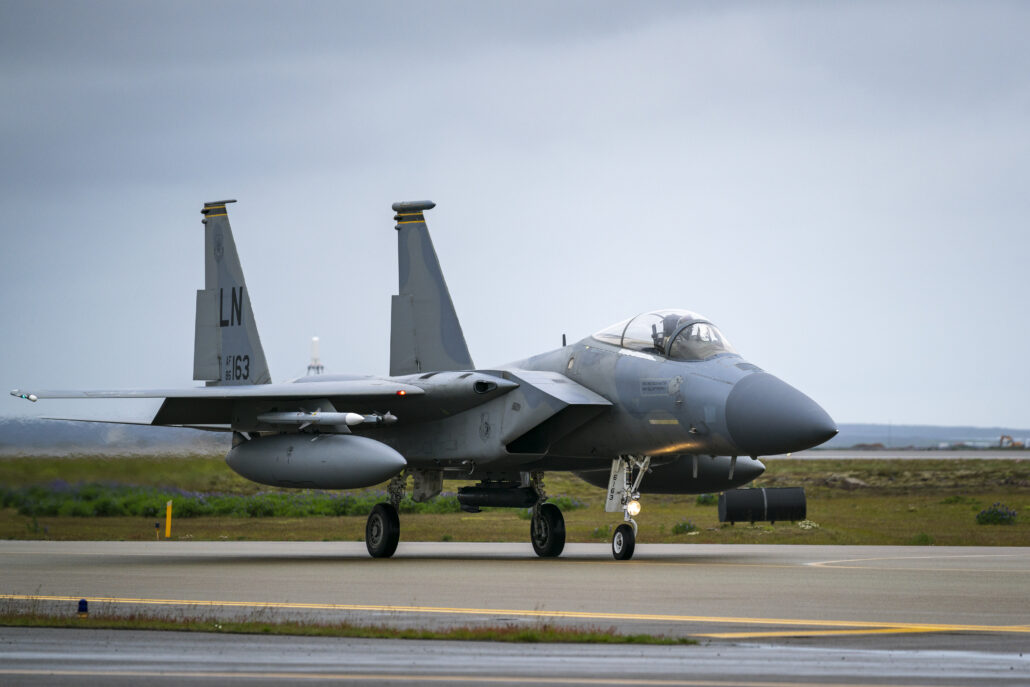






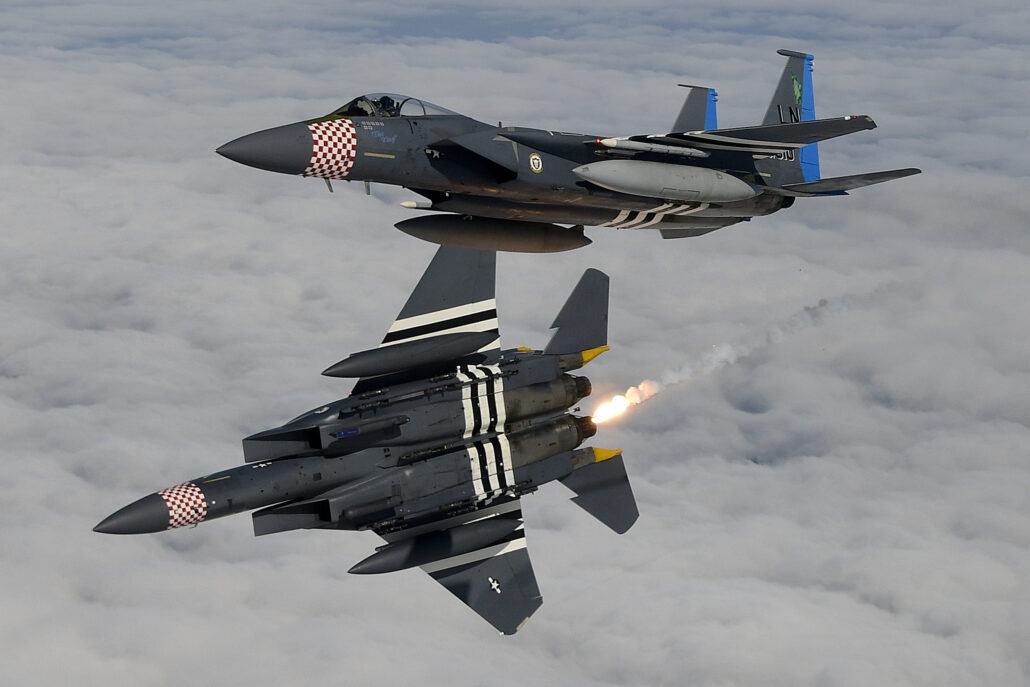








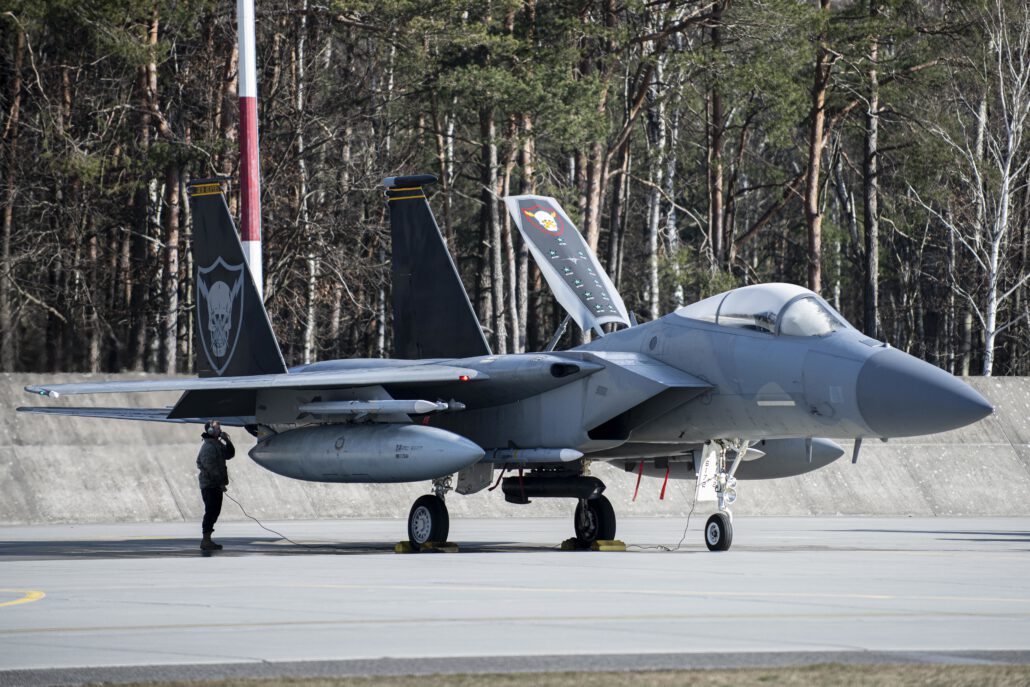
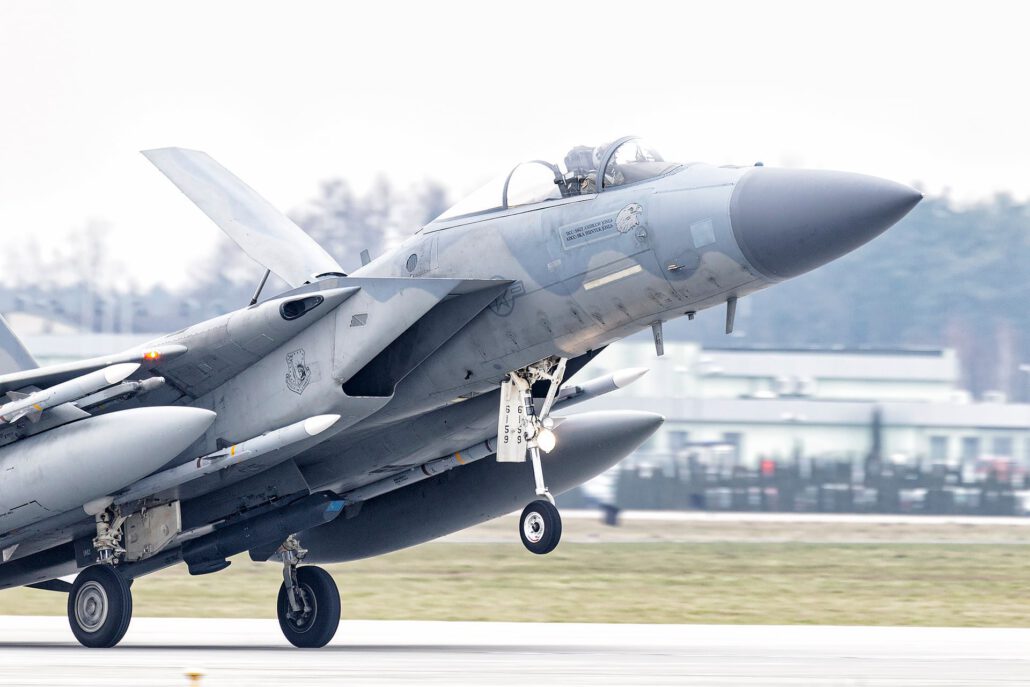
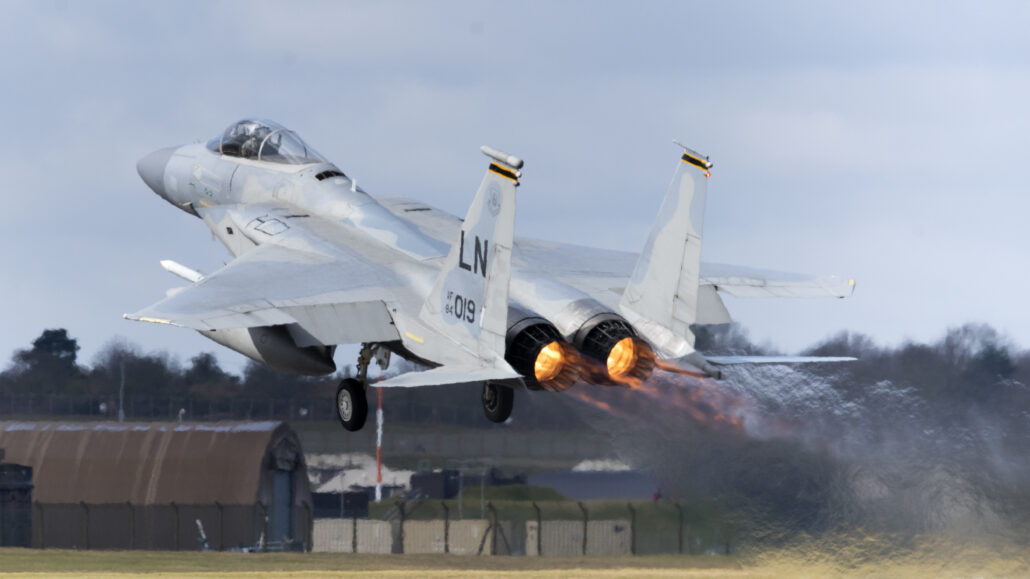







493rd Fighter Squadron ‘Grim Reapers’






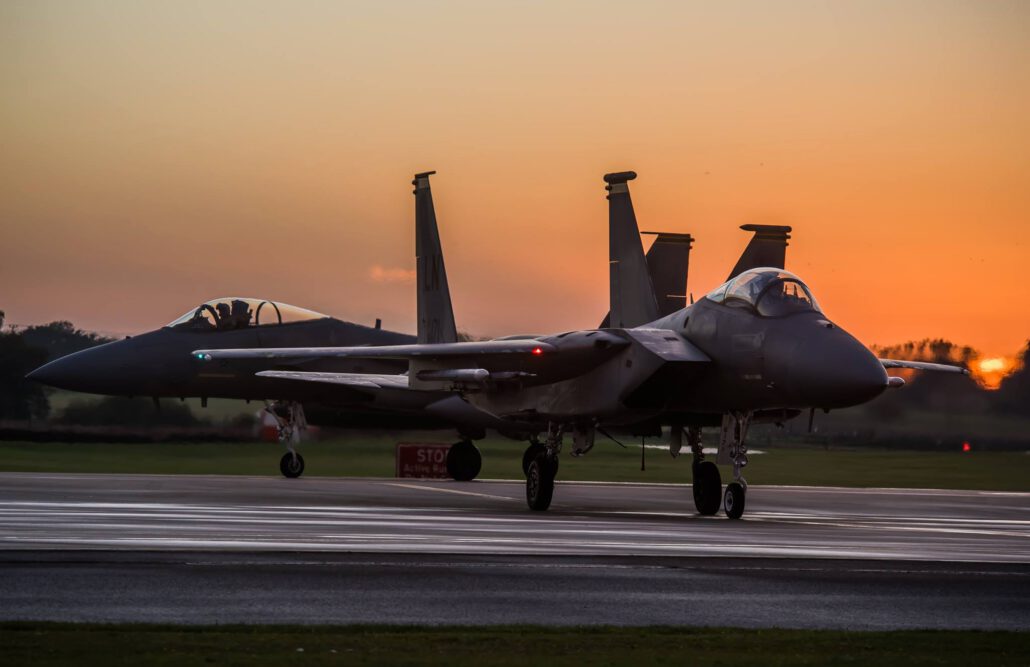


Eagle Sendoff last Eagles in Europe


